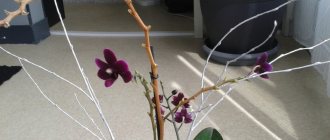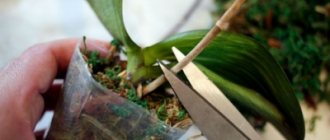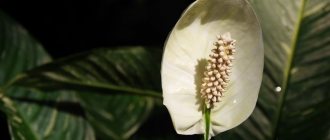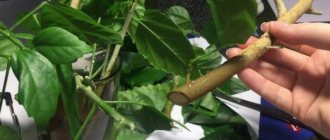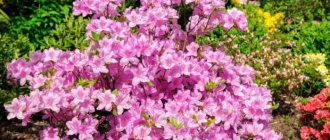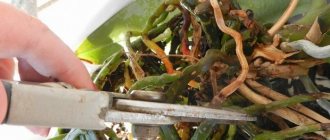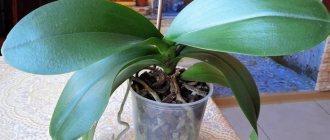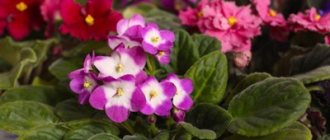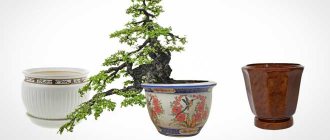Keeping large-leaved garden species in containers
The following describes the regime for keeping large-leaved or garden varieties of flowers in the warm and cold seasons.
From spring to autumn
At the beginning of spring, the containers are taken out of the cellar, fertilized with a mineral composition, and a layer of crushed pine needles or bark is added on top. All bad and weak shoots are completely cut off.
At the beginning of April, the pots with the plant are taken outside, protected from the cold with a special spunbond. Hydrangea should not be left in direct sunlight. By neglecting this rule, you risk ruining not only the decorative effect of the flower, but also completely destroying it.
During the spring, pots or containers with hydrangeas are placed on the southeast side, in a shaded area. After the flowers appear, it is necessary to transfer the plants to the garden
Rainwater is used for irrigation; the soil should always be moist. Important! Until the end of the summer period, it is necessary to fertilize with fertilizers once every 8-10 days.
From autumn to spring
- Immediately after the end of the flowering period, the inflorescences are cut off until strong buds appear. If there are many shoots, they need to be thinned out.
- Then all the shoots are tied up, and the flowers are left in containers until wintering. The leaves should completely fall off.
- Hydrangea is kept in a dark, cool room at a temperature range of 0 to +5 degrees. As soon as the soil becomes dry, you can put snow on top or simply water it with settled water.
Hydrangeas in large pots can be kept at temperatures from +10 to -5 without fear for the safety of the plant and its rhizomes.
Below you can see how to prepare large-leaved hydrangea for wintering:
How to care for hydrangea during dormancy
In winter, hydrangea has a dormant period. In mid-autumn, the pot with the plant should be placed in a cool room with a temperature of 5-8 °C. At the same time, it does not require lighting; for example, a cellar, a dry basement or an insulated loggia will do. Watering is reduced, but it should not be stopped at all so that the roots do not dry out. The rest period lasts 2-2.5 months, after which the pot is transferred to a warm and bright place to awaken. The change in temperature should be gradual; the flower cannot tolerate sudden changes.
Wintering hydrangea
Caring for indoor hydrangeas
It is necessary to care for a hydrangea in a pot, just like a free relative in the garden, by ensuring complete isolation from drafts, otherwise the foliage will begin to wither, until the plant dies, without the possibility of any resuscitation.
Watering mode
Any variety of hydrangea should be watered regularly, preventing the soil from drying out. The water must be left to stand at room temperature. During the flowering period, you need to monitor watering especially carefully.
In winter, soil moisture is also necessary, because the roots should not dry out even during the dormant period.
Top dressing
In summer, hydrangea is in dire need of mineral fertilizers. Additionally, during watering, you can add a small amount of potassium permanganate, which will protect the roots from infection. Without fertilizers, the plant may not enter the flowering stage and remain just a green shrub.
During the flowering period
Blooming hydrangea cannot be replanted so as not to disrupt the natural life cycle of the flower. The air temperature in the room where the blooming beauty lives should be maintained within the range from +18˚С to +22˚С. These are comfortable indications for all varieties.
During the rest period
When the hydrangea has retired, it needs to be moved to a place where the air does not warm up above +9 and does not cool below +5. If a flower is left on the windowsill all winter at room temperature, it will not feel the winter and will not bloom in the new season. For apartments, a balcony or an unheated staircase can become a place where the pot will sit all winter, benefiting future flowering.
Hydrangea doesn't bloom
Preparing for winter
Before wintering, all diseased or weak shoots are cut off, leaving no chance of infecting the entire plant, because treatment is a complex process and does not always result in a positive result. Pots with a plant of any variety and age are moved to a cool place where the shoots will not be blown by winds and subject to frost.
During the dormant period, hydrangea needs to trim dead inflorescences
Growing indoor varieties of hydrangea means bringing joy and bright colors to the windowsill. Indoor hydrangea does not require complex care at home and is ready to surprise with its shades. Following simple rules regarding temperature and frequency of watering will ensure abundant flowering almost all summer and all autumn.
If indoor hydrangea has faded, what to do next?
Pink hydrangea - how to care for pink hydrangea in the garden
At home, the flower can begin to bloom in February. In this case, it will begin to bloom in July. After flowering, the leaves of the bush fall off and vital processes slow down.
If a deciduous hydrangea is chosen, few gardeners know how to care for it. At this time, you should stop feeding and reduce watering. After the leaves fall, the bush should be pruned immediately. If this is not done in time, the hydrangea will stop blooming altogether or will produce scanty, ugly inflorescences. Weak shoots are removed completely, and young and strong shoots are shortened by half. This is also the time to plant the bush in a large pot.
Pruning hydrangea in autumn
Important! In spring, flowering buds form on the current year's shoots, so old shoots need to be safely pruned, and young shoots should be carefully shortened so that the buds remain on the shoot.
In total, it is recommended to leave 5-6 shoots per bush.
Repeated pruning is carried out in the spring. When the bush begins to grow rapidly, in order to prevent it from stretching out, the tops of the shoots are pinched. At the same time, the bush becomes more compact and lush.
Pruning hydrangea in spring
Hydrangea varieties for home cultivation
The most favorite type of most gardeners is large-leaved hydrangea (macrophyll), which includes a large number of varieties. The most popular varieties are those with pink flowers:
- Hamburg;
- Goliath;
- Europe.
Based on large-leaved hydrangea, breeders have created many varieties with different colors, even changing from one color to another. In addition to pink ones, the most common are varieties with blue and white flowers:
- Sister Teresa;
- With classic white flowers;
- Prima;
- Goliath with white and blue flowers;
- Compact.
Based on large-leaved hydrangea, breeders have created many varieties with different colors, even changing from one color to another
Replanting after purchase
You can replant hydrangea only after it has bloomed and the annual pruning has already been done. At this time, the plant prepares for a period of rest and stops its growth. If the plant was purchased in the fall, two weeks after the hydrangea appeared at home, it can be carefully transplanted into a permanent pot. She needs two weeks of rest to adapt to the new room, temperature and air movement patterns.
What is needed for planting
The new pot should be 3-4 cm wider than the previous one. The roots of any variety of hydrangea develop more horizontally than deep, so deep pots are not suitable for it.
The capacity needs to be increased every autumn, allowing the root system to grow and nourish the plant during the period of active flowering.
Optimal place
To ensure abundant and regular flowering, the flower must stand in a sufficiently illuminated area, and not be exposed to direct sunlight. If the room where the hydrangea will live has east or west windows, it should be placed not on the windowsill, but near the window, on the outside of the tulle. This way she will receive enough light, and her leaves will not be damaged by the aggressive sun.
On a north or south window, this indoor beauty can be placed without fear by its leaves directly on the windowsill.
Step by step planting process
Transplantation should begin with the preparation of the earthen mixture. The soil must contain sand and peat, their total share should not exceed 1 part, in relation to turf soil, which requires 2 parts. Be sure to place drainage at the bottom of the new pot. It is unacceptable to include humus in the substrate.
Step by step transplant process:
Prepare a pot lined with drainage. Watering the soil with the plant still in the old pot will make the transfer process easier, preserving the earthen lump. After turning the flower pot over, carefully remove it, holding it by the stems, and then immediately lower it into a new pot. Fill the voids between the rhizome and the walls of the container with substrate so that there are no air gaps left. Once transplanting is complete, water thoroughly.
Additional Information. Replanting hydrangea in the spring can affect its flowering, for which the plant was purchased. Having lost its biological rhythm, hydrangea transplanted in spring will bloom only by next winter.
Growing hydrangea
Caring for a homemade hydrangea in a pot cannot be called the easiest. But by following certain rules, even beginners achieve significant success in growing this attractive flower.
The most difficult thing for a gardener is to maintain the cyclical growth of a crop, because it must be taken care of both during the growing season and during winter dormancy.
Choosing a pot and soil
When growing hydrangeas, choosing a pot is key. Flower growers recommend using either plastic or ceramic bowls. Both options have their advantages and disadvantages. Indoor hydrangea is transplanted into a pot of appropriate size. It should be slightly larger in diameter than the previous one. It is optimal to buy a shallow and wide container - a bowl with a diameter of 20 cm. The gardener should also take into account the place of cultivation of the bush. If it is a windowsill, then the pot should ideally stand on it. For the floor, you can select more massive containers.
Hydrangea prefers acidic soils. It can be planted in prepared soil for azaleas or citrus crops. You can also prepare the soil yourself.
Soil for indoor hydrangea prepared by a gardener contains:
- 2 parts of turf.
- 1 part peat.
- 1 part humus.
- 0.5 parts leaf soil.
All components are mixed well until smooth.
Planting and transplanting
Young specimens are planted in a prepared substrate, having previously laid drainage on the bottom (expanded clay, broken brick, ceramics).
How to replant indoor hydrangea? Breeders recommend changing the soil annually. The transshipment method should be used, keeping the earthen ball undestroyed. Since the root system of a flower is very delicate and fragile, it is very easy to damage it. Transshipment will help avoid the negative impact of the procedure.
When planting or replanting a bush, you should not bury the root collar. It should be placed flush with the soil surface.
Advice ! After winter, many roots die off and therefore should be cut off. Rejuvenation of the root system will ensure stable development.
Reproduction options
Hydrangea is grown from seeds at home if vegetative propagation is not possible. Hybrid varieties are not propagated by seeds collected with one’s own hands.
- Division. The easiest way. During transplantation, the plant is removed from the ground, the rhizomes are freed from the ground, and divided into two parts. An adult, heavily grown plant can be divided into more parts. The roots and shoots are shortened, and the divisions are planted in separate pots.
- By cuttings. Cuttings are cut at the end of winter or the very beginning of spring. Cut from root shoots. 3-4 internodes are left on each cutting. The lower leaves are cut off completely, the upper leaves are cut in half. The cutting is placed at a slight angle in a peat-sand mixture, and the soil is slightly moistened. Before rooting, keep under cover, systematically water and ventilate. Roots appear on average within a month. Wait about two weeks and transplant into a permanent pot with a complete soil mixture.
- Seeds. Sown at the end of winter. Use light, nutritious, breathable soil. Seeds are distributed over the surface of the substrate without being buried. Soil is not sprinkled. Keep under film, ventilate daily and spray with a spray bottle. At the stage of 2-3 true leaves, they are picked into separate cups.
Transplantation into open ground
In the 3rd year after sowing the seeds, the hydrangea is moved to a permanent place. Time depends on region:
- in the south - the beginning of autumn, when the heat subsides;
- in the middle zone - spring or late summer;
- cool areas - the beginning of the season, after the soil warms up to 15 ° C.
Such planting dates ensure the best survival rate. The operation is the same as for an adult hydrangea:
- Dig a hole in advance with a depth of at least 40 cm and a diameter of 60 cm.
- Prepare a fertile mixture of acidic peat, coniferous soil, sand and humus (2:2:1:1).
- Fill the hole and water it with acidified water (1 teaspoon of citric acid per bucket).
- When the time comes for planting, part of the substrate is taken out of the hole.
- Place a seedling in the center. The root collar should be a few cm below the edge.
- Cover with substrate and compress.
- Water with rooting agent. Each pit requires at least 20 liters of water.
- Mulch with bark, acidic peat or pine litter.
- Cover the hydrangea with a box or bucket with a hole in the bottom.
Hydrangeas grown from seeds in open ground are transplanted to a permanent location in the same way. Here, the owners should try to dig out as large a ball of earth as possible and, together with it, move the bush to the planting site.
Air humidity
This is an important indicator both for the person himself and for his green pets. It is very good if you have a humidifier. Hydrangea is moisture-loving. This applies not only to watering, but also to the moisture contained in the air. If you notice that the tips of the leaves are curling and drying out, then it’s time to think about a natural humidifier or a special device that regularly micro-sprays water.
This is not a mandatory but desirable condition. Growing hydrangea in pots has many subtleties, and if you want to see your plant lush and in bloom, then you must adhere to this rule. As already mentioned, at low humidity the tips of the leaves begin to dry out. The plant's immunity drops and it becomes easy prey for pests, such as spider mites.
Hydrangea responds well to regular spraying. Only during budding and flowering should you try not to get on the plant. Otherwise, water stains remain, which spoils the overall appearance of the plant. During this period, you can choose a different method of air humidification. For example, place the pot on a tray filled with pebbles and add water. The second option is to place an aquarium nearby. And of course, for all procedures you need to use soft, settled water.
Features of watering hydrangeas in September
Hydrangea (Hudrangea) translated from Latin means “vessel of water.” The breeders gave this name to the shrub for a reason; the plant needs moisture constantly.
In the first autumn month, watering is no different from summer. The bush must be watered abundantly at least twice a month. For one adult bush, water consumption should be at least 40 liters.
ON A NOTE. Water from a well or water supply must be settled before watering; watering with unsettled water is unacceptable.
Autumn watering stops after the leaves have completely fallen.
Errors in care
Another reason why hydrangea does not bloom is two mistakes in care, insufficient fertilizer and too little water. In both cases, the plant can produce buds and even develop some flowers, but the inflorescences will be anemic and small, withering and turning yellow in the summer. If the bushes are not watered regularly, daily, the plants are unlikely to survive until the next season.
Fertilizer is also important. Flowering shrubs need a lot of nutrients
Because the shrub has large leaves and produces many huge inflorescences, it requires a lot of nutrients. You should fertilize 3-4 times a year if you use granular fertilizer or every second watering if you use water-soluble fertilizers.
The use of fertilizers is closely related to the resistance of the shrub to frost!
Spring and summer. In spring, you can apply complex fertilizer Agricola Aqua. A plant strengthened with nutrients is more resistant to adverse environmental factors, grows faster and produces more flower buds.
Autumn. From mid-July you need to stop using nitrogen fertilizers. Nitrogen stimulates plants to create new shoots and green mass; hydrangeas should be ready for winter rest from August.
However, it is worth using special autumn fertilizers to expand the root system, so that the plants will be better prepared for winter.
Care
In order for hydrangea to recover better after traumatic pruning, it needs to be watered regularly . The soil in the garden bed should be moist. After pruning, it is necessary to feed the plant; adding nutrients will help the hydrangea recover faster. Tissue regeneration will be of better quality. Pruning paniculate hydrangea is required - it will grow:
- well-groomed bush;
- protected from diseases and pests;
- with lush and long-lasting flowering.
Methods for propagating home hydrangea
At home, you can propagate hydrangea in three ways:
Dividing the bush
This is the simplest method of reproduction, which requires great care and compliance with certain rules:
- the bush is divided during annual transplantation;
- all shoots must have a sufficient number of roots and a growing point;
- The shoots and roots of the divisions are first shortened, and only then they are planted in pots and watered.
Bushes divided and planted in spring will take root well by autumn.
Propagation by seeds
Indoor hydrangea propagates by seeds at the end of winter. The soil for sowing should consist of humus, turf and leaf soil (1:1:1). Seeds are sown on the surface of the soil mixture. There is no need to embed them in the soil. The container with the crops is covered with film or glass on top.
Every day, crops should be ventilated and moistened with a sprayer. It is necessary to ensure that the soil is always slightly moist. When the first shoots appear, the film or glass is removed.
As soon as two true leaves appear on the seedlings, they need to be transplanted into a deeper container with the same soil composition. Grown and strengthened seedlings are planted in pots, the diameter of which should be no more than seven centimeters.
Hydrangea cuttings
Experienced gardeners propagate hydrangea by cuttings, as this is the most reliable way to propagate it.
In January-February, cuttings 7-8 cm long are cut from the basal shoots of the plant. Each segment should have up to three internodes. On the upper part of the cutting, the leaves are shortened by a third or half, and from the lower part they are completely removed.
The segments are treated with a root stimulator, planted in a sand and peat substrate, watered and covered with glass jars. This method of keeping them will help prevent the soil from drying out and will maintain optimal air humidity for the development of cuttings.
The container with seedlings should be kept in the brightest place at room temperature 18-20C. After three to four weeks, the cuttings will take root and can be planted in separate pots.
From cuttings rooted in January-February, a bush of 3-4 shoots will grow by autumn. If cuttings are carried out in March-April, the result will be a hydrangea with one stem.
Only caring owners who follow all the rules of care and requirements for temperature conditions, soil selection, lighting and watering will be able to observe the luxury of hydrangea flowering. But such care is worth it. After all, this beautiful plant will look fresh and fashionable in any setting and in any interior. It can be used to decorate residential and industrial premises, winter gardens, balconies, terraces and flower beds.
Growing seedlings
In order for the fragile hydrangea seedlings to quickly strengthen and turn into full-fledged seedlings, they need to be provided with competent and delicate care. It includes the following conditions:
- regular watering and soil moisture;
- optimal lighting;
- comfortable temperature conditions;
- feeding;
- hardening;
- picks.
Watering and moistening
The soil in containers with hydrangea seedlings is regularly moistened, preventing the top soil layer from drying out. Additionally, young plants are periodically sprayed with water from a spray bottle. Spraying will not only replenish the plants' moisture needs, but will also help maintain optimal air humidity. At the same time, water should not be allowed to stagnate in the container with sprouts. Excess water in the tray with seedlings must be drained after each watering. Water the seedlings only with soft, settled water at room temperature. The best time for watering is in the morning.
Lighting
For full development and growth, young hydrangeas require abundant, but soft and diffused lighting. Containers with seedlings are best placed on window sills in the eastern, western, southeastern or southwestern part of the house. It is not recommended to place boxes with hydrangea seedlings in places where the plants will be exposed to direct sunlight for a significant part of the day. If your hydrangea bushes look weak, drooping or wilted at the end of the day, this may indicate they are overheating. In this case, the pots with seedlings should be moved to light partial shade.
Temperature
Hydrangea seedlings sprouted from seeds are sensitive to changes in air temperature. In order for young plants to feel good, the air temperature in the room must be maintained at +15... +20° C
It is important to consider that a sharp drop in temperature for unhardened seedlings can be disastrous, as can exposure to drafts. Both young hydrangea seedlings and adult plants should be protected from drafts
Feeding
Before transplanting into open ground, it is recommended to periodically feed hydrangea seedlings. Fertilizing is carried out during the period of growth and development of green mass, using complete complex fertilizers (“Aelita-Flower”, “Fertika Lux”, “For hydrangeas and rhododendrons” from Pokon). It is advisable to feed young plants 1-2 times a month.
Hardening
Before planting in open ground, hydrangea seedlings should be hardened off. This procedure will increase the endurance of young plants and increase their resistance to low temperatures. The hardening process is carried out gradually. To do this, containers with young plants are placed on the balcony for several hours every day. Over time, the length of time the seedlings stay on the balcony increases, removing them only at night.
Picks
Growing hydrangea seedlings from seeds requires 2 pickings. These procedures are necessary for the full development of young plants, the active growth of their green mass and root growth. In the absence of picks, the seedlings will begin to stretch upward, weaken, oppress and shade each other.
The first picking is carried out after the seedlings have 2 developed cotyledon leaves. At this stage, the plants are planted in containers at a distance of 10-12 centimeters from each other. The second picking is carried out at the end of spring. During this period, young bushes begin to actively grow green mass, requiring a sufficient amount of free space. At this stage, hydrangea seedlings are planted in separate pots.
Growing large-leaved hydrangea in a pot: everything you need to know
Large-leaved hydrangea is a real beauty. Juicy green leaves and large caps of bright inflorescences make it a real decoration of the garden, but there is one “but”: the heat-loving beauty does not always winter safely in the open ground. Very often, even with shelter, the shoots of the bush freeze and thus deprive gardeners of the pleasure of admiring the flowering next season, which is the main advantage of the plant. However, not everything is so sad and there is a good way to avoid such a situation and preserve flower buds - to grow hydrangea as a potted crop. Of course, this changes its care a little, but, in general, it won’t cause much trouble; moreover, it’s much easier to care for a compact bush. But what exactly needs to be done is what we’ll talk about today.
Types of procedure
There are several types of hydrangea pruning. Namely:
- Plant-shaping pruning gives the branches a well-groomed appearance.
- Annual pruning to obtain a powerful, profusely flowering plant.
- Sanitary pruning consists of removing damaged dry inflorescences.
- Rejuvenating cardinal pruning is carried out on old or damaged bushes.
Formative
Pruning will make paniculate hydrangea a shrub with a lush, well-groomed crown.
You can form a hydrangea in the second year of plant growth. When forming a bush form, the main trunk is first created by eliminating zero shoots (growing from the ground). When the hydrangea is of the required height, a crown is formed.
To create a ball, four or five strong shoots are left , the rest are cut off. Hydrangea has the peculiarity of producing zero shoots; flower buds rarely form on them.
The crown can be designed in two versions: in the form of a tree or a bush. Clean the plant by removing the lower branches, and remove the upper ones in case of frostbite in the spring.
According to the pruning scheme, they distinguish:
- bush;
- bush with a raised crown;
- standard with a straight or drooping crown.
Regulatory
During sap flow, the branches are trimmed to form a neat crown. This will help to achieve more lush and abundant flowering, because inflorescences form on young shoots, but on old shoots there will be no flowers from last year. Pruning will help get rid of dry branches that limit flowering and will give the opportunity to develop new shoots that limit flowering.
The peculiarity of this shrub is that the more you prune, the more abundantly it will bloom in the next season. In place of the cut branches, young ones grow, bearing flowers.
Rejuvenating
If the bush needs to be rejuvenated, then pruning is carried out with a canopy .
All shoots are cut to the stump. Timely cleaning of the plant will help the hydrangea stay young and eliminate diseased, damaged, and broken branches. Pruning will maintain the appearance of the plant and start restoration processes. If the bush has grown, radical autumn pruning is carried out for three years. Paniculata hydrangea should be pruned annually in the spring to encourage the growth of new branches.
Radical pruning will help the bush to rejuvenate, form more lush inflorescences , and correct the shape of the plant. Pruning will not reduce the volume of the plant; when planting, the space necessary for growth should be allocated for it. The plant needs this type of pruning to stimulate the growth of flowering shoots.
Sanitary
This type of cleaning is carried out in the fall. The main purpose of sanitary pruning is to remove diseased, broken and weakened branches. Weak bushes are shortened from the base to the width of the palm.
If pests appear on the plant, carry out radical sanitary pruning . Remove the bushes so that stumps half a meter high remain. The next year, after deep intervention, the plant will not bloom, but will be saved. Flowers will appear in a year, after radical pruning the plant will form a crown and recover.
You can stimulate strong, mature bushes by pruning them to 2-3 pairs of buds. From each bud a new shoot will appear with an inflorescence at the end.
Hydrangea care at home photo: main nuances of content
Indoor hydrangea, which is properly cared for at home, will definitely thank you for your efforts with long and lush flowering.
Temperature and lighting
When deciding on a location for it, it is important to choose one where direct rays of the sun will not fall, but where there will be plenty of light. The ideal distance for hydrangea would be 2-3 meters from the window.
In this case, development will be normal, and light spots will not appear on the leaves.
As for temperature, the main thing is to avoid sudden fluctuations and protect the hydrangea from drafts. 19-22°C is exactly the indicator at which the flowers will feel as comfortable as possible. It is best to put hydrangea away for the winter in a dark, cool room (up to 9°C), for example, in a cellar, and return it back to the room closer to February. Without such a decrease in temperature, the plant will bloom only next year.
Indoor hydrangea care at home photo: watering and fertilizing
The second name of the flower, hydrangea (literally “a tub of water”), speaks of a great love for water. Hydrangea at home requires regular and generous watering in the summer, and more moderate watering in the off-season. In winter, you need to especially carefully control the amount of moisture in the flowerpots to avoid rotting of the root system and death of the plant.
Melt, rain or settled water is great for hydrangeas. Occasionally you can add lemon juice (5-7 drops per liter). This will help prevent the leaves from turning yellow. Systematic spraying and, of course, keeping the flower pots themselves away from heating appliances will help prevent them from drying out.
It is necessary to add organic and mineral fertilizers to the soil in the summer to speed up the development and flowering time of hydrangeas. Spraying with gibberellin (0.1 g per 1 liter of liquid) is also excellent for such purposes. With the appearance of the first flowers, a weak solution of manganese can be added to the irrigation water, and in winter, fertilizers can be abandoned altogether.
Indoor hydrangea care at home video
To better understand, watch the video in which Candidate of Biological Sciences, Elya Mamedova, confirms that this unpretentious plant can look flawless and truly excellent even for beginners.
https://youtube.com/watch?v=bMKtqDtGHpg
Care after pruning
After pruning, it is very important to follow proper care to ensure that the shoots grow as powerful as possible. First of all, you should take care of systematic watering and feeding of the plant. It should be watered periodically and the top layer of soil should not be allowed to dry out. It is very important that the soil is always slightly moist. This will contribute to a fairly rapid recovery of hydrangea.
Important! The specifics of the pruning method being carried out and the need to cover the plant for wintering depend on the type and variety of hydrangea growing in the garden plot.
Fertilizing should also only be done in moist soil . For this purpose, special mineral fertilizers are used, which contain potassium, nitrogen, phosphorus and many other microelements. Mulching the tree trunk circle is done with manure, compost and peat, the layer of which should be about 5 cm. This will help protect against the formation of a dry surface layer on the soil and retain moisture inside it for as long as possible.
When asking yourself whether there is a need to prune hydrangeas, you can clearly answer that the presented procedure is extremely necessary. At the same time, it is very important not only to choose the season in which this process will be implemented, but also to decide for which variety it will be performed. Indeed, depending on whether you are dealing with large-leaved, paniculate or tree-like hydrangea, the features of the procedure for this plant also depend.
Propagation by cuttings
Growing indoor hydrangea is quite simple, and even a novice gardener can cope with the task. Start the procedure in early February, then by the end of the year you will get strong bushes with 3-4 branches. For cuttings, use root shoots. Cut these shoots into pieces 7-8 cm long. Make sure that each cutting has at least three internodes.
Remove the lower leaves of the branches, and cut the upper plates to a third of the length. Dip the cuttings in a growth stimulator and deepen them 2-3 cm into a mixture of peat and sand. Cuttings of home hydrangea quickly take root in this substrate.
How to care for planting? Maintain a temperature near the branches from +18 to +20 °C and humidity - 75-80%. It is easier to create such an environment if you cover the cuttings with glass jars. But do not forget to ventilate the planting daily and periodically spray the soil with warm water from a spray bottle.
After 3-4 weeks, when the cuttings take root, accustom them to the open air. To do this, remove the cover for an hour, then two and gradually increase the time. Transplant the stronger branches into individual containers with a diameter of 7-9 cm.
Reproduction
Method 1. Dividing the bush
An adult hydrangea will be happy to share its shoots with you to grow new flowers! The root shoot is separated directly in the pot: it is advisable to find and cut off the shoot with its roots.
Transplant it into prepared soil (drainage at the bottom and loose soil for conifers or azaleas) and cover it with cellophane: this is your kind of greenhouse. Open it periodically and monitor the rooting: after a few weeks, the new hydrangea will already have acquired its own strong root system and begin to grow.
Method 2. Propagation of indoor hydrangea by cuttings
You can also get “offspring” from hydrangea by cuttings. To do this, you need to select the upper or lower shoots about 5 cm long (the main thing is that they are young and the bush does not bloom). The shoots are carefully broken off and planted in wet sand. If you have the opportunity, you can treat the broken area with a root-forming compound.
The shoots will also need a greenhouse (from cans, transparent glasses, cellophane, etc.). After a couple of weeks, the shoots should take root: periodically open your mini-greenhouses and check the rooting. In about a month, they can be transplanted from the sand into the soil familiar to hydrangeas, and soon the young shoots will begin to grow.
Good luck propagating your beautiful hydrangeas!
Botanical description of hydrangea and its species
The plant, in the form of a compact spherical bush with pointed, large, rich green leaf blades, begins to bloom in the spring and ends in late autumn. The inflorescences have racemose and umbellate shapes with two types of flowers:
- sterile (with large petals located at the edges);
- forming seeds (small, in the central part of the inflorescence).
The shape of the inflorescences resembles large balls (up to 30 cm in diameter), which have different colors: blue, pink, cream, pale white. One bush forms up to 7 inflorescences located on the tops of the shoots, the size of which depends on their number: the more pieces, the smaller the size.
Hydrangea (hydrangea) is a decorative flowering perennial of the Hydrangeaceae family.
Experts note several interesting features of the plant:
- The color of the flowers depends on the composition of the soil. With increased acidity, blue and blue shades are obtained. Alkaline soil will result in a pink color, and neutral soil will result in a white or slightly creamy color.
- The beginning inflorescences are very delicate. One touch could kill him. Therefore, it is not recommended to remove drying flowers.
According to various sources, there are about 80 species of the hydrangea family in the world, which grow in China, Japan, America and the Far East. Not all of them are grown at home.
Flower growers breed indoor and garden hydrangeas in the form of shrubs and trees
The gardens contain shrubs, vines and trees. The most famous types include:
- Large-leaved hydrangea, growing up to 2 m, is decorative not only with large inflorescences, but also with dark green leaves with jagged edges. For cultivation in open ground in Russia, only cold-resistant varieties are cultivated. Low-growing species are selected for indoor breeding.
- Paniculate hydrangea, which is more cold-resistant and reaches a height of 50 cm. At the end of the summer, white flowers bloom on the shrub, the color of which turns into crimson and purple. After winter, it is recommended to perform formative pruning of the bush.
- Chereshkova. It has small bright green glossy foliage and flexible shoots with aerial roots, thanks to which the plant can cling to neighboring trees or building walls. There are whitish-green inflorescences along the entire stem.
- Oakleaf. A little more than 1m high. It has leaves similar to oak leaves, changing color with the onset of cold weather.
Transplanting hydrangea into a new pot
Flower growers do not consider the houseplant hydrangea to be capricious; you still need to know how to care for it in order to grow a healthy flower.
Reproduction by dividing the bush
Autumn is the best time to propagate a plant by dividing the bush. During this period, active vegetative growth stops, so dividing the bush and replanting the hydrangea easily tolerates. This is one of the easiest methods of reproduction.
Additional Information! You can grow hydrangea from seeds. They can be purchased at any flower shop. The disadvantage of seed propagation is the duration of growing seedlings.
The process of propagation by dividing the bush:
- the bush is taken from an old pot;
- the plant is divided into several parts so that shoots and live buds are in equal numbers on each of them;
- the pot is half filled with soil;
- a separated part of the plant is placed in the center of the pot;
- the pot is filled to the top with soil.
At the end of planting, you need to water the bush generously with warm water. Some parts can be planted in open ground if the bush has grown too much and there is no longer enough space for it at home.
Pruning and replanting a bush
Caring for hydrangea mix at home involves regular pruning and replanting of the flower. Pruning is carried out twice a year - in spring and autumn. If necessary, you can additionally trim the bushes in the summer.
Attention! In summer, mostly only faded inflorescences are cut off, which spoil the appearance of the plant. You can also trim off yellowed leaves.
In autumn, pruning is carried out after flowering. The procedure is necessary in order to prepare the flower for winter. Using sharp pruning shears, cut off the entire leafy part almost to the root. The cut areas can be sprinkled with wood ash to prevent diseases.
In spring, all weak and overly elongated shoots of colored hydrangea must be cut off.
When transplanting for soil use:
- humus;
- coarse river sand;
- peat;
- turf;
- leaf soil.
You need to take two parts of leaf soil and humus, and one part of all other ingredients. All ingredients are thoroughly mixed until a homogeneous substrate is obtained. During planting, drainage (expanded clay or small pebbles) is usually poured into the bottom of the pot, and then soil. Drainage is necessary so that if the soil becomes waterlogged, the root system does not begin to rot too quickly.
Using soil you can change the shade of the inflorescences. Hydrangea is an unusual plant. It, like litmus paper, reacts to changes in soil composition. If you acidify the soil, the color of the inflorescences will be more saturated.
In soil with neutral acidity, hydrangea flowers will be white or cream in color. In slightly acidic soil, the inflorescences acquire a bluish color. And if the soil is acidic, the flowers become a rich pink or lilac hue. To increase the acidity of the soil, you need to add sawdust, peat, and coniferous soil to it.
Note! Hydrangea needs to be replanted every year. She lives at home for no more than 3-4 years
Then you need to plant a new plant.
Optimal timing
Pruning hydrangea depends not only on the place where the flower grows, but also on the type of plant - large-leaved, paniculate, tree-like.
In order not to make mistakes and trim on time, you need to familiarize yourself with the technology of the process. The procedure is carried out in spring and autumn:
- In spring, it is important to adhere to the deadline for pruning hydrangeas; you must not allow the buds on the branches to bend. Then it will be clear in which direction the new shoots will grow, but the plant can be harmed.
- It is important to know when to form a plant, trim last year’s old branches, and rejuvenate the bushes.
Attention! Shoots pruned after the required time will already begin to grow and will bleed juice, begin to get sick, may not bloom and even die.
in autumn
In autumn, plants are cleaned mainly in September , hydrangea changes color and blooms beautifully, just like in summer.
Hydrangea is pruned according to the type of flowering. Young shoots are not touched. Remove only broken and old branches growing inside the bush. The purpose of autumn pruning is to prevent thickening, stimulate the growth of young shoots, and make the appearance of the bush aesthetic.
For the first three years, autumn pruning is not recommended . In order to take root and survive frosts, a seedling needs strength. Only necessary sanitary cleaning can be done. Old plants are cut off, leaving small stumps 8-10 cm high from the roots. Otherwise, the roots will not receive the elements necessary for growth and the plant will die in winter.
Autumn pruning is needed in order to improve and shape the crown of the plant.
in spring
In the spring, preferably in March, sanitary pruning should be carried out. First of all, dry, weak, damaged branches that have frozen over the winter are cut off.
Important! Paniculata hydrangea tends to thicken. It is necessary to thin out the branches. A lot of inflorescences and bushes will have a negative effect on the plant. The branches will be weak and the inflorescences will be small.
You can re-thin the branches in the spring on bushes that were thinned in the fall. During the movement of juice, this must be done with extreme caution so as not to destroy the plant.
Should I prune for the winter?
Hydrangea paniculata is pruned for the winter at the end of October, at which time the plant is dormant.
Only branches sticking out inward are trimmed, the main (skeletal) bushes are not touched , dried panicles are removed so that young branches do not break off under the weight of snow.
After pruning, it is advisable to cover the plant for the winter. For dry shelter, the plant is wrapped with spunbond or lutrasil. You can also cover it with plastic film, but under it in the spring the plant may receive excess moisture.
When is it better - spring or autumn?
The plant is cleaned both in spring and autumn, but autumn pruning is better, since in the spring juices begin to circulate in the bush ; when pruning branches, the plant releases juice abundantly, and this can lead to the death of the bush.
Plants that are too old are cut at the root - all branches are removed, small stumps 8-10 cm high from the roots are left. But, if the plant is too large, the procedure must be extended over several years, otherwise the roots will not be able to receive all the substances necessary for life and will die.
Cleaning hydrangeas in the fall is more beneficial than in the spring.
Main problems and solutions
Is there something wrong with your hydrangea? Below we will look at the most common problems.
Indoor hydrangea does not bloom
If the plant is still young, there is nothing to worry about: the first time a hydrangea can bloom even after 5 years.
If everything was fine before, the problem may be due to the fact that the flower was pruned before wintering. Buds will no longer appear on new shoots; they needed last year's ones. The lack of light and fertilizing can also have an effect, as well as their abundance.
“What should I do then?” - newcomers ask in panic. Take care of your plant, observing the golden mean in all aspects of care. Almost always all problems (if they are not insect damage) come down to the consumption of light and water.
My hydrangea is turning yellow
Often the cause is a lack of acid in the soil. Try watering the flower with water acidified with lemon juice.
My hydrangea leaves have dry spots and thinning.
This is an obvious burn of the leaves: remove the flower from the sun, look for a more shaded place to permanently locate the pot.
There are yellow spots on the leaves of my hydrangea and a gray coating on the back side.
This powdery mildew is a frequent visitor to homes with young plants. Their affected shoots need to be removed, or it would be better to burn them, and the flower should be treated with special fungicides.
My hydrangea leaves are covered in brown growths.
This is rust, most likely caused by overwatering or heavy fertilizing.
Diseased leaves are removed and, as is the case with all such lesions, the hydrangea is treated with fungicides.
Someone has settled on my hydrangea
A sticky web indicates the appearance of a spider mite, which can be removed with a soap solution or chemicals from specialized stores.
Leaf aphids are clearly visible: small pests swarm on the leaves. They can be removed by applying tobacco ash or special chemicals.
Don't be afraid to plant this beautiful flower for dreamers. A noble and surprisingly bright hydrangea will decorate the house with rich, pointed foliage and caps of small flowers that look like colored clouds. A little “discipline” and it will bloom happily. Good luck with your care!
- Caring for spathiphyllum at home
- Indoor flowers and plants for the kitchen - choose unpretentious, useful and beautiful
- How to get rid of midges in flowers
- How to care for aloe at home
- 12 super ideas for crafts for the home and kitchen
- Kitchen panels - ideas and instructions
- Kitchen wall decor - 12 super ideas
- Kitchen design and decor - site guide
Hydrangea: care in autumn and winter at home
Despite the fact that hydrangea is quite thermophilic, it is important for the plant in an apartment to ensure the correct temperature conditions in the autumn-winter period. If this is not done, the hydrangea will not bloom next year or will die altogether.
Preparing hydrangea for the dormant period begins with the arrival of autumn. With the first cold weather, the plant is limited in watering and stopped feeding
Please pay attention to these important points:
Light mode.
After active flowering is completed, the hydrangea is pruned and the flower pot is sent to a cool and dry room.
Never deprive your hydrangea of sunlight. If you want to move the flower to a shaded room, gradually accustom the hydrangea to shorter daylight hours.
When the flower is completely dormant, the amount of light will not matter significantly.
Temperature regime.
Hydrangea must be protected from sudden changes in temperature. Although the optimal air temperature for hydrangea is 15–22 °C, the plant should overwinter at a temperature of 5–9 °C. The decrease in temperature should be gradual.
The best option for keeping hydrangeas in the winter-autumn period is a dry, ventilated room - a basement or semi-basement.
To awaken, it is worth returning hydrangea to the room at the very end of winter or early spring. A signal that a flower is ready for a new growing season is the sprouting of buds.
Do not immediately bring hydrangea into a warm room. Like leaving for the winter, the return of the flower to the room should be gradual, without a sharp change in temperature.
Watering hydrangeas during wintering is kept to a minimum. The earth ball in the pot is moistened as needed so that the soil does not dry out at all.
Replanting, pruning or feeding a flower during dormancy is strictly prohibited.
If you need to transplant the hydrangea into a larger container, it is better to do this after flowering. Young plants are replanted annually. Copies older than 3 years - once every 2-3 years.
The choice of hydrangeas for growing at home is limited by the availability of space and desire. Breeders offer gardeners more than 85 types of hydrangeas.
Some of them require increased attention and are demanding in terms of living conditions. Other types cause virtually no trouble. The most popular and unpretentious species are tree hydrangea, paniculate and large-leaved.
If you follow the recommendations for caring for hydrangea, almost any of them can be domesticated. Large-leaved hydrangea is considered the most decorative plant variety.
Give the hydrangea a little time and surround it with care. In return, the plant will delight you with lush and vibrant flowering year after year.
What different types of hydrangea need in September
The main difficulty in caring for an unpretentious plant is that there are several varieties of the crop.
The most famous and popular three types:
- paniculata;
- tree-like;
- large-leaved.
Each of them needs special care. But in the first autumn month, all types of perennials require the same care, including watering, fertilizing, preventive spraying against pests, insects and diseases. The only differences are pruning and covering for the winter.
Hydrangea home planting and care
It is recommended to carry out annual plant replanting in the autumn - after flowering has completed.
Indoor hydrangea care and replanting
A suitable soil would be a mixture of turf and leaf soil, peat and regular sand in proportions 2:1:0.5:1
It is also important not to forget about good drainage
You can achieve a certain shade of hydrangea flowers by changing the acidity of the soil in which it will be grown. For blue, you need to take more acidic soil, white and beige petals will bloom in neutral, and for pink, alkaline soil is ideal. Also
This phenomenon is explained by the ability of plants to accumulate aluminum. You can oxidize the soil using pine needles, peat or sawdust, and to alkalize it, add a little ash, chalk or lime. In addition, there are special fertilizers from Color Me that contain the necessary elements to give the hydrangea the desired color.
Hydrangea roots tend to grow wide. Pots should be low and wide enough. Each new flowerpot should be 1.5 times larger than the previous one.
Home hydrangea care and pruning
After flowering, the bush must be trimmed, leaving only healthy stems. Weak shoots, as well as the top of the flower, should be disposed of so that a beautiful and lush bush can form in the future.
How to propagate hydrangea at home
Home hydrangea propagates in two ways: division or cuttings. During transplantation, an adult flower can be carefully divided into two or more bushes. For cuttings, as a rule, small young shoots (up to 6 cm long) are selected, the sections are lubricated with a special preparation Kornevin and placed under a cap in moist soil. They are getting along great.
Subtleties for different types of plants
Paniculate
Formative pruning of paniculate hydrangea is carried out in the canopy; for this purpose, the skeletal branches are not touched, only those growing inside the bush are pruned. Be sure to cut off the dried buds, do not remove the entire shoot . New branches are thin and may not withstand the weight of snow. If the plant needs to be rejuvenated, several shoots growing from one point are removed and one or two are left outside.
Formation is carried out in the spring - frozen branches are removed. The crown can be made in the form of a tree, forming a standard. The resulting bouquet on a stem will adapt to the cold over time and will not need shelter.
tree-like
Tree hydrangea cannot be pruned for the first three years, otherwise the plant may die. Only faded branches on annual bushes are removed. In the fall or after the first frost, cut off the old buds so that there are still 3-4 pairs of buds left on the shoot.
On tree hydrangea, the buds grow in pairs (next to each other). Therefore, the faded part is removed, and the remaining part is not touched so that the bush remains lush.
The plant is covered for the winter. When rejuvenating the bush, all the shoots are cut off under the stump , leaving only ten centimeters.
Hydrangea is rejuvenated by removing overgrown bushes for three to four years. The size of the inflorescences depends on regular and correct pruning.
Large leaf
In the spring, sanitary cleaning is performed if it is necessary to remove problem areas. Large-leaved hydrangea is thinned out in the spring to avoid thickening. But this must be done before the buds open. In order to wait for beautiful buds in the new season, you need to prune large-leaved hydrangea carefully; the panicles are removed after flowering so that the plant has young shoots before the onset of cold weather.
If the bush has bloomed heavily, it is necessary to thin out the branches growing inward and young branches, making room for new shoots. The plant is rejuvenated by removing most of the old branches, shortening them to 30-40 cm regularly over three years. Before insulation for the winter, old bushes are trimmed, the foliage is cleaned and wrapped with film.
Scheme: how to correctly form according to the type of tree?
In the first three years of life, hydrangeas produce a crown.
Skeletal branches are formed - this is the support of the entire plant. In the second year in the spring, last year's shoots are shortened to the base , and a skeletal support is created.
In the third year, cutting off the branches, leaving 1-3 buds on the shoot. Branches growing inside the crown must be removed; they thicken the crown.
Attention! To form into a tree it is necessary to have strong and tall varieties with strong shoots.
What to do with potted hydrangea in spring?
Around the end of March, the overwintered hydrangea should be taken out of the basement, shed with warm water and fed. If necessary, the bush can be transplanted into a larger pot, and after watering, be sure to mulch it to retard the evaporation of moisture. Before “moving” outside, the pot needs to find a bright place in the house.
For feeding, it is better to use a special long-acting complex fertilizer for hydrangeas (in granules). Coniferous litter or pine bark is well suited as mulch - rotting, it additionally acidifies the soil, and hydrangea loves this.
You can take hydrangea into the garden no earlier than the end of April, or even in May, but at first take it into the house at night or cover it with agrofibre so that the bush does not suffer from return frosts.
Particular attention should be paid to the location of the hydrangea in the garden, because it does not like too bright lighting, which will cause the flowers to fade. While there are no buds, the east side is best
And during flowering, it is worthwhile to completely remove the bush under a canopy so that the sun hits it only in the evening.
Answers to frequently asked questions
What are the subtleties in pruning hydrangeas in September?
During the stem trimming procedure, you need to know exactly what type of shrub it is. This will help not only to form a bush, but also to see lush inflorescences next year. It is important to remember that the large-leaved variety forms inflorescences only on last year’s stems.
Should I water in September?
The plant needs proper watering. In moderate weather, watering is done at least once a week, in extreme heat - twice a week. If it rains frequently, it is necessary to monitor the soil; if it has dried to a depth of 5-6 cm, watering is resumed. The culture loves moist soil.
Where to plant hydrangea in September?
The proverb “Measure twice, cut once” directly applies to choosing a place to plant a perennial. Before planting a crop, you need to think carefully. Too much shade and bright sun at midday are definitely not for this plant. The area should be well lit in the morning and evening, and at noon should be in soft partial shade.
How to prepare a site for planting?
You should never neglect the fact that the crop “likes” acidic soils. Only in such soil will the plant feel comfortable. Whenever possible, it is necessary to acidify the soil with peat or pine needles. Watering with citric acid for a short period of time can also help.
